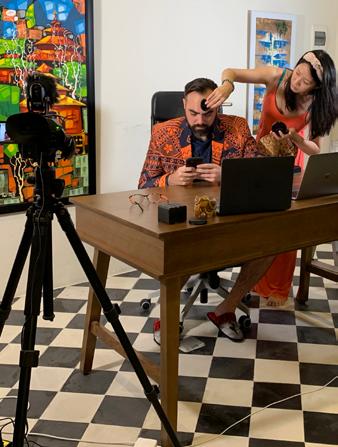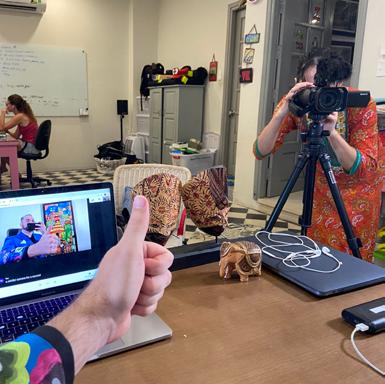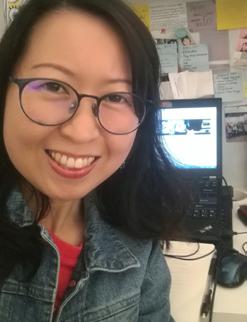
4 minute read
The global team (Media MICE and
Covering the Ophthalmology Globe
from East to West with
Da Nang, Vietnam




Chandigarh, India
Georgia, USA




Da Nang, Vietnam
Glasgow, Scotland

Manila, Philippines



Pearls and Pitfalls

While Performing Intrascleral Fixation of Intraocular Lens with the Yamane Technique by Joanna Lee
Picking up pearls on the Yamane technique is like a walk on the beach when expert guidance is at hand. CAKE Magazine’s staff would know (the beach is a few blocks from our satellite office in Da Nang, Vietnam).
Chasing the heels of the relatively new flanged, sutureless intrascleral haptic fixation (ISFH) technique developed by Dr. Shin Yamane, beginner surgeons participated in a masterclass held on day 2 of the American Society
of Cataract and Refractive Surgery
Virtual Annual Meeting (ASCRS 2020). Course moderator Dr. Surendra Basti from Northwestern University (USA) has taught on this subject extensively while the comprehensive session featured several experienced physicians in this area.
Expert teachers string up good advice for surgery
Kicking off the session, Dr. Mitchell Weikert from Baylor College of Medicine (Texas, USA) walked the audience through the basic steps of the Yamane technique. Full of tips in between as he explained, his video covered needle choices, pre-test haptic insertion, use of AC maintainer, and choice of lens. One of the most important aspects is the needle angulation where he showed how to insert the needle: “What you want is to approach the surface of the eye at a 45˚ angle, embed the tip through the conch into the sclera and then flatten your angle out. That way, you can make your pass more accurately,” he said, also noting the AC maintainer helps make needles pass through easier. While the technique has many advantages, there are common intraoperative mistakes that a beginner should learn to avoid. Dr. Sam Garg, vice-chair of Clinical Ophthalmology and Medical Director of the Gavin Herbert Eye Institute at the University of California, Irvine (California, USA) spoke about these common errors. “One mistake is to not watch videos, attend courses as well as to practice (in wet labs and OR) prior to trying this out in patients,” he said. He pointed to Dr. Bryan’s Kim’s well-narrated videos as one of the leading sources of information on pearls and modifications on the Yamane technique. To avoid using the wrong lens, he recommended using the ZEISS CT Lucia 602 lens (Carl Zeiss Meditec, Jena, Germany), an advice echoing Dr. Weikert in his earlier presentation. This is due to its haptics being resilient to damage, making it ideal for this procedure. Other mistakes include inaccurate orientation incisions, not marking correctly, needle related mistakes like bend techniques, and uneven tunnels among others.
Managing postop complications
instructor from the Jules Stein Eye Institute at UCLA, Dr. Nicole Fram who highlighted pupillary capture, IOL tilt, decentration and haptic extrusion as key complications that doctors should watch for. The key thing is to understand sclerotomy entry needs to be a 180˚ from each other to avoid decentration. “Tilt happens because your tunnel lengths are asymmetric,” she said. Taking down the conjunctiva, she said and reiterating Dr. Basti’s point earlier in the course, is an important tip for beginner surgeons so they could better see what they’re doing.
“The angle of entry where the haptics want to comfortably exit out of the eye is important – this is why Dr. Yamane spoke about the 20˚angulation of the scleral tunnel to the limbus,” she said. Dr. Fram proceeded to demonstrate more surgical techniques and showing mistakes and how to mitigate them.
Yamane technique in rare cases
Prof. Surendra Basti then spoke on performing the Yamane technique in unusual situations, focusing on pediatric eyes, eyes with conjunctival abnormalities and eyes with partial capsular support. For children below the age of 2, the challenge arises from their thin sclera and narrow palpebral fissure. The narrow orbital space exerts considerable distortion to needle-haptic complex of first needle pass, so Dr. Basti suggests to consider externalizing first the haptic before making the second needle pass. Chemosis, subconjunctival hemorrhage and prior conjunctival surgeries were discussed along with how to handle abnormal sclera (in Marfan’s syndrome patients). As partial capsular support situations are optimal cases for beginner surgeons, he also offered several tips on handling cases like this. “It’s important to be mindful of placing the haptic that needs intrascleral fixation first before positioning the second haptic.”
The session ended with a discussion of challenging cases with all instructors presenting challenging cases of ISHF intrascleral haptic fixation with conditions such as when the patient has no iris, reverse pupillary block which manifests as UGH syndrome and or recurrent pupillary capture of optic and malpositioned PCIOL and Soemmering’s Ring.



